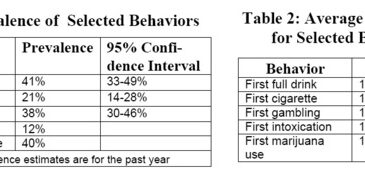Marijuana and alcohol are commonly considered to be “gateway” drugs; their misuse is often considered the first step in a pattern of addiction and substance abuse. Thus, for many users, alcohol and marijuana represent their first exposure to psychoactive substances. Might gambling also be a gateway behavior? This is one of the research questions posed by Westphal, Rush, Stevens, and Johnson (1998) in their study of adolescents placed in juvenile treatment facilities in northwest Louisiana.*
The 135 subjects who agreed to participation were residents of five short-term treatment centers designed for adolescents with behavioral problems. Ages ranged from 12 to 18 years, with a mean age of 17 years. Fifty percent of the sample were black males, 22% were white males, 14% were white females, 9% were black females, and 5% were classified as “other.” In addition to the SOGS-RA, researchers administered an instrument concerning demographics and substance abuse. Subjects completed questionnaires in classrooms under test-taking conditions, and all responses were anonymous. Tables 1 and 2 present the most salient results.

Analysis of confidence intervals indicate that the prevalence estimates of level 2 (problem) and level 3 (pathological) gambling in this treatment population are significantly higher (alpha=.05) than those computed meta-analytically by Shaffer, Hall, and Vander Bilt (1997; 14.8% and 5.7%, respectively).** Yet the more interesting finding is the early age of onset for gambling behavior. Subjects reported an average age of 11 for their first experience with gambling, the same age reported for first experiences with alcohol and tobacco. That experimentation with gambling occurs concurrently with first experiences with illicit substances does not necessarily imply a causal relationship. In fact, it may be the case that age 11 is the point at which children begin to experiment with altering consciousness. However, such concurrence does raise the possibility of gambling’s role as a gateway behavior to substance abuse. Unfortunately, the study did not report the order in which subjects engaged in activities so we cannot know whether the onset of gambling behavior preceded or followed the onset of substance use. A closer look at pre- and early-adolescent gambling seems warranted.
Sources:
* Westphal, J.R., Rush, J.A., Stevens, L., & Johnson, L.J. (1998). Gambling behavior of adolescents in residential placement in northwest Louisiana. Southern Medical Journal, 91, 1038-41.
**Shaffer, H.J., Hall, M.N., & Vander Bilt, J. (1997). Estimating the prevalence of disordered gambling behavior in the United States and Canada: A meta-analysis. Boston, MA: Harvard Medical School Division on Addictions.
This public education project is funded, in part, by The Andrews Foundation and the National Center for Responsible Gaming.




